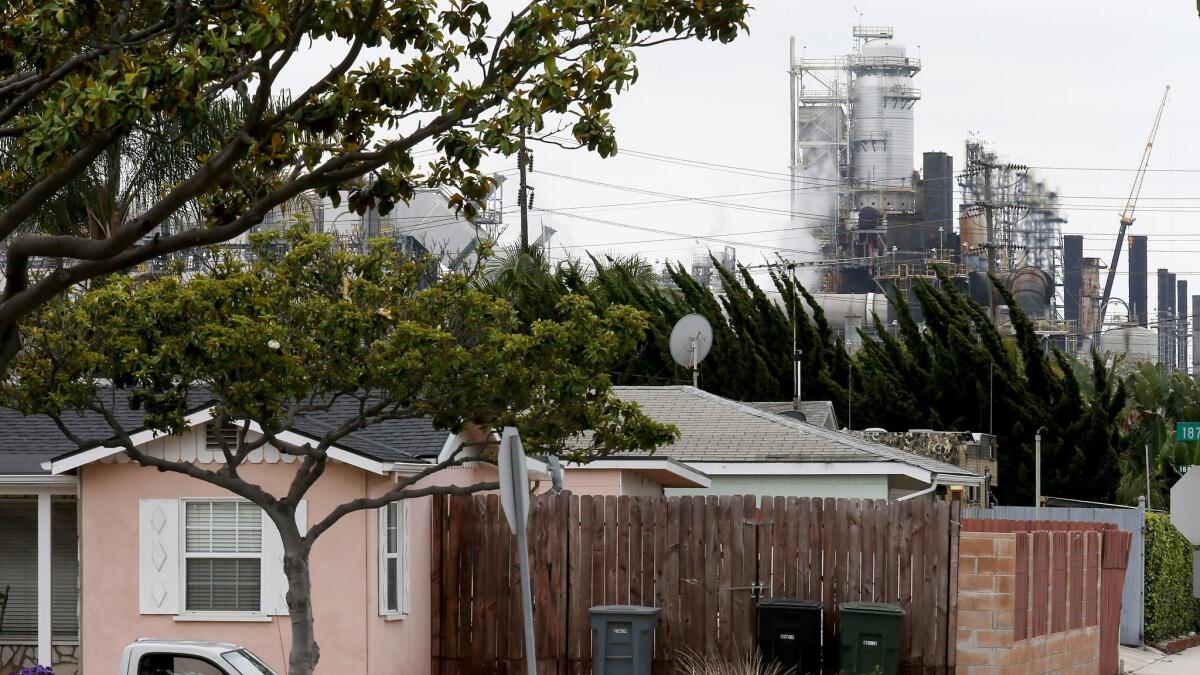Southern California oil refineries ordered to monitor, publicize neighborhood air quality

Oil refineries must install air quality monitors at their fence lines and pay for pollution monitoring systems in surrounding communities by 2020 under rules adopted by Southern California regulators.
The measures approved Friday by the South Coast Air Quality Management District board will provide the public with real-time information on refinery emissions, but do not include requirements that facilities reduce pollution when high levels are found.
The rules come as a series of fires, explosions, flaring episodes and other incidents has sent smoke, dust and other pollutants into the air in recent years, stirring community anxiety about the dangers of living near California refineries.
The region’s eight major oil refineries in Carson, El Segundo, Paramount, Torrance and Wilmington will be required to make the pollution readings they collect available on a website.
The monitors — likely to include optical remote sensing devices and other new technologies — will measure 15 refinery pollutants, including smog-forming gases and toxic compounds like benzene, toluene and hydrogen cyanide. Regulators said the devices will provide data on routine emissions and accidental releases and also could help find and address leaks that might be going undetected.
Air district officials said the rules were drafted concurrently with legislation Gov. Jerry Brown signed in October that requires air monitors to be deployed at refinery fence lines and in nearby communities by 2020.
The measures earned praise from community groups, environmentalists and local officials who have long sought more information on what people near the sprawling facilities were breathing.
“Refinery emissions affect our communities at all times, especially our children,” said Maria Ramos, a member of Communities for a Better Environment who lives near a refinery in Wilmington. “But we are not aware of the levels of emissions that are being spewed into the air or what chemicals we’re being exposed to.”
Mayor Albert Robles of Carson, home to two refineries, welcomed the monitoring but criticized the rule because it “does not provide a mechanism to address the health risks once the monitoring data is gathered and known” and “makes no requirements for the refineries to take action to control these emissions.”
The Western States Petroleum Assn. supports the monitoring rules, Southern California region director Patty Senecal said.
The community monitoring network, paid for by fees charged to refineries, could include traditional fixed stations as well as remote sensors distributed throughout neighborhoods, officials said. The air district will consider suggestions from the public as it decides where to deploy those monitors.
The rules will phase in over the next two years, along with an array of other refinery monitoring standards being rolled out by state and federal officials. Those include U.S. Environmental Protection Agency rules requiring fence-line monitoring for benzene and other mandates under recent legislation that extended the state’s cap-and-trade program for greenhouse gases.
Bay Area pollution regulators adopted similar requirements for fence-line monitoring at oil refineries last year.
More to Read
Sign up for Essential California
The most important California stories and recommendations in your inbox every morning.
You may occasionally receive promotional content from the Los Angeles Times.











